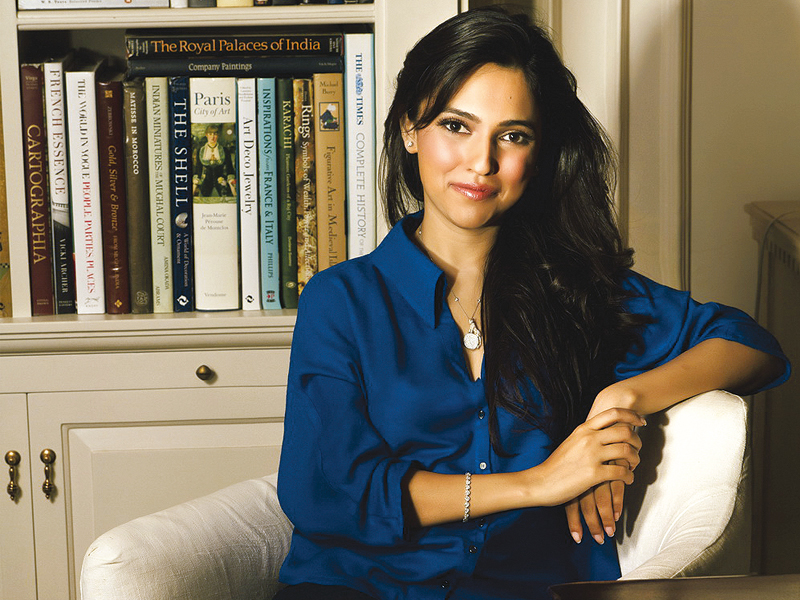
Her dadi hails from Lucknow, and her nani from Bombay. Taking cue from her heritage, Nida Azwer began collecting intricate pieces and through them, developed the aesthetic sense that defines her label — Nida Azwer Atelier. If she gets to know of someone who is selling an heirloom, she is the first one to say, “Let me take it!” She commits to the fact that she is here to save the dying crafts of yore, not to do away with them.
We first meet Azwer in her studio located off Sunset Boulevard. In between the constant flurry of activity from the people popping in and out, she informs The Express Tribune that she graduated from the Indus Valley School of Art and Architecture (IVS) in 2005 and took around three years to officially launch her brand at a solo fashion show. Clad in a black outfit from her White Label collection, Azwer is herself a poster child for the ideal that her label embodies. When asked how she would define the quintessential Nida Azwer woman, she says, “She is chic, classy and elegant.” Any names she’d like to share from the entertainment industry who fulfill these requirements? “Mahira Khan and Meesha Shafi,” she says.

What motivates her to do what she does is an incident, where a woman told her, “Nida, if you don’t create a demand for it, people won’t follow.” People in this part of the world have become so modern that doing away with old things has become norm. Nobody cares to cherish the crafts of yesteryear, such as tukri ka kaam, rilli and zardozi, to name a few.
Azwer says, “I am known for my craft revival. I do a lot to revive our old techniques. I want to bring something previously unavailable to the floor. I use fabrics such as pure silk, brocade, Italian Lamé, French Chantilly Lace and fine Swarovski crystals. People who come here are looking for timeless pieces. Something fun, yet chic and classic.”
Azwer designs for all kinds of clientele, from prêt to bridal for women, to a line completely dedicated to kids, and even a men’s line. Anything that excites the young designer becomes part of her work aesthetic. She tells us, “For my prêt wear, I like doing digital and screen printing, and for my formals, I like to create surfaces with heavy embroidery,” she explains.
So, what’s her signature as a designer? “I think I have too many ideas, and I like creating things that challenge me. Most people who come here rely on the cuts, structure and embroidery I drape them in. Also, I love playing with colours.” Animals are a recurring theme in her collections, “Phoenixes, peacocks, birds and elephants are constants in my work. Demand does change though, so I now have more floral prints in my collection,” she says.
Juggun Kazim is the face of her latest offering, the Hyderabadi collection. It is inspired by the Nawabs of Hyderabad, says Azwer. “The world saw the Nawabs of Hyderabad portray their wealth through their attire. What we see in old images is that their dressing wasn’t typical,” says Azwer. “Their dupattas weren’t your average length of two yards, they stretched to six! They wore resham kay kaam ka lenhga or even farshi ghararas. So, I took it as my inspiration and translated that. I retained their cuts and added to them my own designs and patterns.”
She was recently involved in bringing forward a Shahtoosh Shawls collection, for private collectors. Of this collection, she says, “Look, it’s not completely Shahtoosh, it’s mixed with Pashmina. I don’t feel controversial about it and nobody else does either.” The shawls are undoubtedly beautiful, with Mughal inspired embroidery. The eye-catching colour contrast of navy blues with red, dark brown and rust is a feast for the eyes. She adds that the shawl collection is for the discerning buyer, because of its price range. “People here just don’t want to take the risk of experimenting with Shahtoosh, they’re too afraid of it getting torn mid-way!”
When asked who she believes is doing well in Pakistan as a fashion designer, she quips, “Apparently, everyone is doing well. That’s why you see more faces coming in.” As for her inspirations on both the international and local front, she says, “Tomas Maier, I really like his work, there is a lot of detailing in it. And the business model of Sana Safinaz is really good. I can’t produce in bulk like them, but I still like it.”
Published in The Express Tribune, December 26th, 2013.
Like Life & Style on Facebook, follow @ETLifeandStyle on Twitter for the latest in fashion, gossip and entertainment.
COMMENTS (6)
Comments are moderated and generally will be posted if they are on-topic and not abusive.
For more information, please see our Comments FAQ

1736298376-0/Untitled-design-(56)1736298376-0-165x106.webp)





















If you deal in Shahtoosh (aka wool sourced from endangered animals), then you are never going to be a a brand of choice for me.
And yes, I can afford it, but I choose not to thank you very much.
IS SHE NEW IN BUSINESS? I like new talent
@Maq: How come my comment is not there but you have replied to it, its an opinion? Pakistanis with no identity are ashamed of themselves. Thats all one can fathom.Whatever happend to Pukistan the land of the "pure", whatever happened to Allah.
Awesome:)
@LunacyAsailam: Burqa is just a cultural thing and nothing to do with Islam.Pakistan metropolitan cities never had burqa clad women,seems you have been living in doldrums.